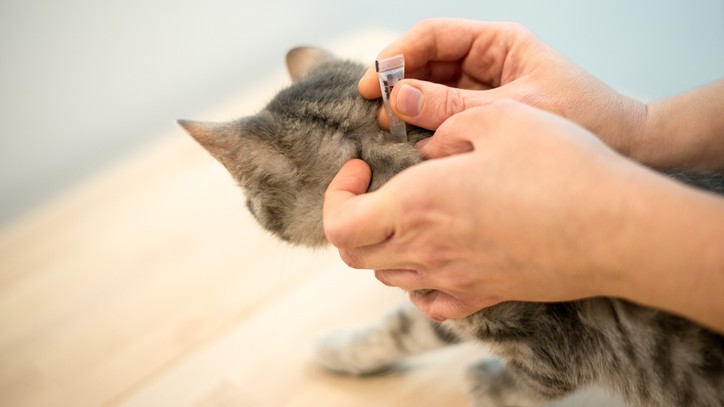
Flea medicine vs flea collars - which one is best? If you’re new to pet parenthood, then you probably have this question. Fleas cause itching, discomfort, and irritation — and in some cases, dangerous health issues that could pass on to humans.
The best flea treatments for dogs and best flea treatments for cats can be given topically or orally, but they both spread a drug around your pet’s body, either in their skin oils or bloodstream. When a flea tries to feed on them, the insect will be poisoned by the ingredients. Flea collars sometimes contain a repellent and release the medication slowly over time.
If you can’t decide between the two, vet Dr. Joanna Woodnutt is here to help. Below, she’s compared the pros and cons of flea medicine vs flea collars, and given her expert advice on which one is best. The answer is different for everyone and will depend on your pet’s lifestyle, health, and susceptibility to fleas.
How does flea medicine work?
Flea medicine is available in several forms. Spot-on liquids are a very common and popular form of flea medicine, but flea tablets are also becoming more common. They work in various ways and contain a variety of different active ingredients, depending on the product and the brand. Some are prescription-only, and others can be bought over the counter.
Flea medications work in different ways, but in all cases, the active ingredient is a drug that is more toxic to insects than it is to mammals. The drug spreads around the body in the skin oils or the bloodstream, then poisons any insects that feed on your pet.
Here's more information on how topical flea treatments work and the safest flea treatments for dogs.
What are the advantages of flea medicine?
Giving flea medicine to your pet is a reliable way to prevent flea infestation. They're usually easy to give – the spot-on medications simply get applied to the skin where your pet cannot lick them off, and many of the tablets are flavoured or chewy to encourage pets to eat them. The medications can last from one to three months, providing long-lasting and continual protection.
Many flea medications are also effective against other pet parasites, like ticks, mites, lice, and some intestinal worms. They are usually very fast-acting, with some formulations acting within just 30 minutes to treat all adult fleas living on the pet.

Wht are the disadvantages of flea medicine
Flea medicines are chemicals that are toxic to fleas. Unfortunately, this means they’re probably toxic to all insects. So, by treating your cat or dog for fleas, you might inadvertently be killing bees and other beneficial insects. While we're yet to find out if the newer tablet-style treatments cause problems, imidacloprid is a common ingredient in spot-on treatments that is known to have severe and long-lasting effects on insects. And when your dog rolls in the grass or goes for a swim, the medication may enter the environment, damaging our wildlife.
In addition, flea medicines can have side effects, varying from patches of hair loss and sore skin to vomiting and wobbliness. While these are usually rare and mild, there are particular breeds and individual dogs that shouldn’t have some medications.
This is why the best flea medications are only available from the vet or with a written prescription from a vet – they're best placed to make sure your flea medicine is as safe as possible for your canine companion or feline friend. However, this tends to make them more expensive than simple shop-bought supplies.
Flea medicine: Verdict
Flea medicine remains an effective way to prevent these parasites from choosing your pet as their favorite fodder. However, the most effective products are only available from the vet. The vet will need to conduct – at a minimum – an annual evaluation to check that the product is the best one for your pet. The great news is that no matter your pet’s individual needs, there will be medication out there to help them.

How do flea collars work?
Flea collars are another method of flea prevention. Some collars contain a repellent designed to stop fleas from attaching to your pet and coming into the house. Others include a combination of repellent and pesticide, which rubs into the skin on your pet’s neck and then acts in the same way as a spot-on medication.
What are the advantages of flea collars?
Flea collars are long-lasting and easy to apply to most pets. They can also be one of the cheaper flea treatment options out there, depending on the brand and frequency that you need to use them.
Some flea collars are specifically recommended for certain insects because the repellent action prevents insects from biting and stops them from transmitting diseases to your pet.
If you think this is the best option for your pet, check out our guides on the best flea collars for dogs and the best flea collars for cats.
What are the disadvantages of flea collars?
Most vets will agree that the vast majority of flea collars in the supermarket aren’t effective, but there are a couple of brands that are.
Flea repellent collars are rarely strong enough to do a good job, and fleas can easily hitch a ride with your pet, then go dormant until the collar starts to run out.
This is particularly true if you have a large pet, as the repellent may not be enough to keep fleas away from their entire body. So, you might find a congregation of fleas on their back end!
It's also essential to think about collar safety. Collars can cause significant injury and occasionally death if they get caught on fencing or undergrowth. Therefore, cat collars should not be stretchy but should instead have a quick-release feature that causes the collar to snap if too much pressure is put on it. This means that if cats become stuck, the collar snaps to release them.
This safety feature is life-saving. However, it does mean that collars get left behind and frequently lost, so their protection is sometimes limited. It’s important to remember that collars need to be worn continuously to work.
Although they can get wet in the rain, prolonged wetness or frequent bathing should be avoided for most collars, making them a poor option for dogs that like to swim or need regular grooming.
Flea collars: Verdict
Flea collars are usually less effective than medications, but there are a few exceptions. And while some of the most effective flea collars remain prescription-only, Seresto has recently been recategorized as a POM-VPS product. This means you can buy it from other qualified people, for instance, in a pet shop or pharmacy. Take care to purchase from reputable companies, though; there have been many reports of ineffective fakes since Seresto was downgraded to POM-VPS.
Which flea treatment is right for my pet?
The flea treatment that best suits your furry family member will depend on their lifestyle, as well as their tolerance of the medication. If your dog swims a lot or needs regular baths, a tablet flea treatment is probably the most appropriate. On the other hand, if your cat or dog sees red when you try to give them a tablet, you might be more sensible to reach for a collar or spot-on medicine. After all, it’s not worth losing fingers!
If you've reached the end of this discussion and don't like the sound of flea medicines or flea collars then why not check out these simple home remedies for fleas on dogs. Or perhaps it's time you get to the bottom of 'how do cats get fleas?' to help you prevent this from occurring to your feline friend.
We’ve also answered: How often should you treat cats for fleas? And do dogs carry bed bugs?







